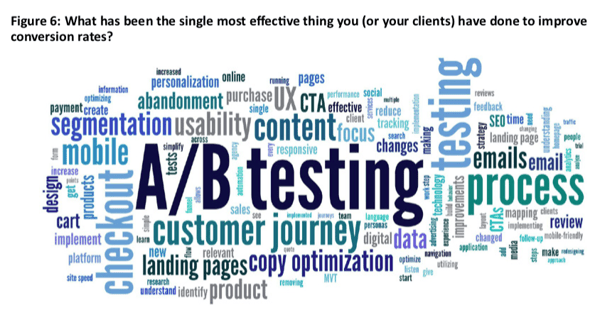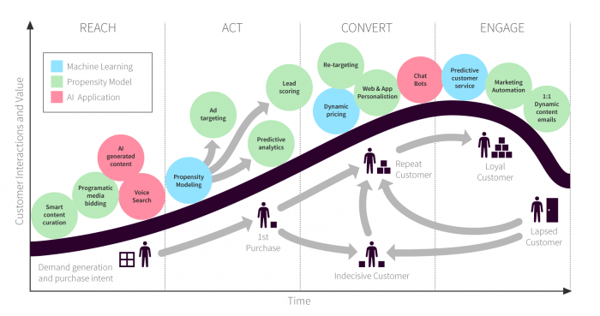August Round-up: Better Meta Targeting, Google Glitch & UX Best Practice
The latest version of our newsletter should have settled in your email inbox, detailing the need-to-know information and must-read thought leadership...
Read moreDr Dave Chaffey lifts the lid on this top 5 predictions for the world of conversion rate optimisation. Discover more.
I recently attended the Data-driven business event in London. I was interested to attend since there were separate streams covering growth hacking, predictive analytics and email innovations.
A great opportunity to learn from specialists working in these areas and case studies on a subject very close to my heart, and our approach at ClickThrough Marketing. I'd been invited to speak on the opening keynote on email marketing trends and the closing summit on conversion rate optimisation. In this post, I'll run through some of the main predictions I covered.
This is more of a hope or a wish than a firm direction. I was making the point that there is still a label / perception of CRO = AB Testing of landing pages? This is suggested by this Econsultancy report on CRO where the most common activity is clearly A/B testing.
 Other usability techniques were surprisingly deployed rarely, in particular qualitative techniques.
Other usability techniques were surprisingly deployed rarely, in particular qualitative techniques.
My point here, was that if we focus on individual pages, without context, our attempts to improvement don't take into account customer behaviour. I gave the example of Stacey, a car-buyer research by Google who was found to have over 900 different online and offline touchpoints on the path to purchase. It's a fascinating example if you don't know it:
To support these complex journeys requires more than simple AB testing. It includes targeting optimisation through personalisation; content, media and creative optimisation and Messaging optimisation taking different cultural preferences into account.
In future this will be supported by Big data analysis ; AI and machine learning and Qualitative Voice-of-Customer research.
I also recently spoke at an event hosted by Vision Critical where interestingly the audience was brand community market researchers, showing how larger businesses tend to operate in silos.
It opened my eyes to how brands are using panels for ideation for new propositions, concept testing and optimisation of messaging. This example shows how Prudential Singapore launched the PRU for You (PFY) community in July 2016 to allow greater engagement with customers and to give them a voice in developing new products and services. PFY has 4,500 members: 88% are customers and 12% are agents.
It later launched two products resulting from PFY feedback—PRUman and PRUlady, covering illnesses specific to men and women. This is a world-away from CRO showing how traditional market research can support proposition development.
As marketers today, we’re fortunate to have a huge number of free and low-cost tools to give us insight about our customers, competitors and market.
To help highlight the range of great options available, I've developed an updated infographic covering Digital Marketing Technology across 30 categories of marketing technology and picked the most popular 5 in each category.
Talking to Richard Chapman who heads our CRO team, it's common to see the scope of tools like Visual Website Optimizer which is our chosen tool expand. In time, many of these may be included within Marketing Cloud services or analytics tools which is the case with Google Analytics and their Optimize tool.
Finally, on more of a personal development note I looked at where job roles would be in 10 years time. I asked people in the audience to suggest what their role might be. I remember some fun answers including "Machine Learning Analyst" and "Robot AI Administrator" or similar. I reviewed some of these examples of applying AI for marketing:
 We discussed where chatbots and natural language generation tools would get to, will our landing pages write themselves if we give them a goal? I doubt it. My serious point was that with the main types of "Artificial Intelligence applications" it will be difficult for marketers to compare different "Black box" AI solutions without testing and understanding their training data sets and their bias, how they are interpreted.
We discussed where chatbots and natural language generation tools would get to, will our landing pages write themselves if we give them a goal? I doubt it. My serious point was that with the main types of "Artificial Intelligence applications" it will be difficult for marketers to compare different "Black box" AI solutions without testing and understanding their training data sets and their bias, how they are interpreted.
So I suggested that understanding the principles of machine learning is the best targeted learning since many of the marketing applications of AI shown above do relate to predictive analytics and machine learning based on analysis of historical data sets.
If you'd like to learn more from Dr Dave Chaffey, or explore Conversion Rate Optimisation further by chatting to our experts, get in touch today.
More articles you might be interested in:

The latest version of our newsletter should have settled in your email inbox, detailing the need-to-know information and must-read thought leadership...
Read more
As the cost of living continues to present challenges for many Brits, an increasing number of families are choosing to holiday within the United...
Read more
Our first curated newsletter has hit inboxes, detailing all of the latest need-to-know information and sharing all the necessary thought leadership...
Read more
Over the past few years, marketing leaders have been gearing up for the inevitable 'Cookieless Future'. Safari was the first to bid farewell to...
Read more
It only seems like yesterday that it was the winter of 2022 and we were balancing Black Friday and the Qatar World Cup. Fast forward to now and we're...
Read more
There are many factors to consider when choosing an automotive dealership, with 53% of customers saying that price determines which dealership they...
Read more
Which UK-based private healthcare providers are running away with their digital presence and who needs a helping hand to take the next step? How is...
Read more
How prepared are you for planning & budgeting season? Dave Chaffey shares some of the questions you should ask yourself when planning marketing...
Read more